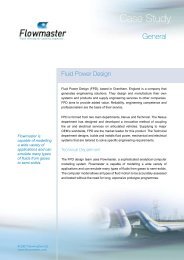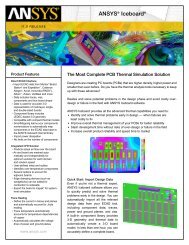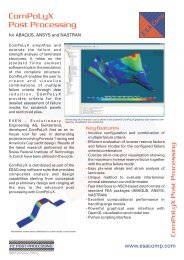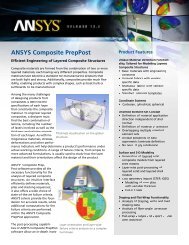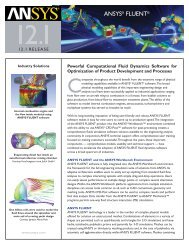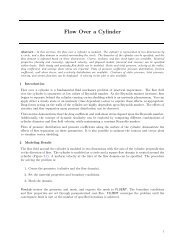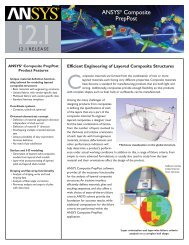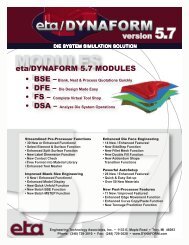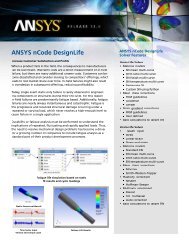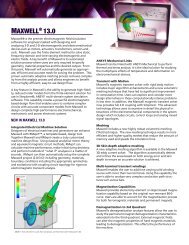ANSYS POLYFLOW - PhilonNet Engineering Solutions
ANSYS POLYFLOW - PhilonNet Engineering Solutions
ANSYS POLYFLOW - PhilonNet Engineering Solutions
Create successful ePaper yourself
Turn your PDF publications into a flip-book with our unique Google optimized e-Paper software.
<strong>ANSYS</strong> <strong>POLYFLOW</strong><br />
Powerful Fluid Dynamics Software for<br />
Parts Manufacturing Processes<br />
For the last quarter-century, <strong>ANSYS</strong> ® <strong>POLYFLOW</strong> ® software has been the<br />
flow analysis code of choice of leading manufacturing companies in the<br />
polymer, glass, metals and cement processing industries. The technology<br />
is used extensively to design and optimize processes such as extrusion,<br />
thermoforming, blow molding, glass forming, fiber drawing and concrete<br />
shaping. Recognition of the value of <strong>ANSYS</strong> <strong>POLYFLOW</strong> is due to a unique<br />
combination of capabilities:<br />
• Advanced material rheology models, including viscoelasticity<br />
• Deforming mesh, free surface tracking, contact detection and mesh<br />
superposition technique<br />
• Reverse engineering methods such as inverse die design and parison<br />
programming<br />
• Finely tuned solver numerics and post-processing<br />
Design engineers regularly choose <strong>ANSYS</strong> <strong>POLYFLOW</strong> POL software to<br />
minimize physical prototyping when manufacturing an extrusion die or<br />
reducing thickness variation to improve the quality of thermoformed<br />
or blown products. Customers report dramatic return on investment once<br />
they’ve introduced <strong>ANSYS</strong> <strong>POLYFLOW</strong> fluid dynamics modeling into their<br />
design processes.<br />
<strong>ANSYS</strong> <strong>POLYFLOW</strong> and the <strong>ANSYS</strong> Workbench Environment<br />
<strong>ANSYS</strong> <strong>POLYFLOW</strong> software is fully integrated into the <strong>ANSYS</strong> ® Workbench<br />
environment, the framework for the full engineering simulation suite of<br />
solutions from <strong>ANSYS</strong>. Its adaptive architecture enables users to easily set<br />
up any problem from standard fluid flow analysis to complex interacting<br />
systems with simple drag-and-drop operations. Within <strong>ANSYS</strong> Workbench,<br />
applications from multiple simulation disciplines can access tools common<br />
to all, such as CAD connections, geometry and meshing tools. <strong>ANSYS</strong> CFD-<br />
Post software can be used to compare results and to perform final data<br />
analyses.<br />
These capabilities allow opportunities for Simulation Driven Product<br />
Development (SDPD) to drive innovation, enabling users to perform<br />
virtual prototyping, process optimization and virtual part testing in a<br />
scalable and cost-effective manner.<br />
Application <strong>Solutions</strong><br />
Coextrusion Rubber Parts<br />
Extrudate<br />
Dieland<br />
Coextrusion of a soft (green) and dense<br />
(grey) rubber for automotive profile<br />
Glass Gob Forming<br />
3-D transient modeling of the forehearth<br />
and single gob forming process<br />
Extrusion Blow Molding<br />
Parison programming and extrusion<br />
blow molding using shell elements<br />
forming process
Application <strong>Solutions</strong><br />
Extrusion Blow Molding<br />
Velocity distribution in the die land<br />
and large die swell induced by stress<br />
relaxation<br />
Thermoforming<br />
Thickness distribution in a thermoformed<br />
dashboard; small thickness<br />
(blue) is seen as potential weakness<br />
Profile Extrusion<br />
Comparison between the desired<br />
profile (black) and the prescribed<br />
die lip automatically calculated<br />
by <strong>ANSYS</strong> <strong>POLYFLOW</strong> software<br />
(red) for a foamed extrudate profile<br />
Solvers and Numerics<br />
Industrial processes modeled by <strong>ANSYS</strong> <strong>POLYFLOW</strong> involve multiple nonlinearities<br />
and, thus, require a heavy-duty, efficient solver. Nonlinearities<br />
can stem either from complex rheological or thermal-dependent material<br />
behaviors or from large deformations (such as die swell, blow molding,<br />
thermoforming, glass pressing, etc.). <strong>ANSYS</strong> <strong>POLYFLOW</strong> software uses<br />
the finite element analysis (FEA) method, which is ideally suited for<br />
efficiently modeling flows of a complex rheological nature. It can easily<br />
accommodate deforming boundaries through its robust arbitrary<br />
Lagrangian-Eulerian (ALE) deforming-mesh capabilities. The software<br />
scales to solve advanced physical problems and simplifies the workflow<br />
for flows with complex geometries.<br />
Advanced parallel processing numerics can efficiently utilize multiple<br />
multi-core processors in a shared memory machine. This reduces the<br />
turnaround time for results. <strong>ANSYS</strong> <strong>POLYFLOW</strong> software is available on<br />
Windows ® and Linux ® platforms.<br />
Viscoelasticity and Complex Rheology<br />
One of the key inputs to any successful numerical model is properly<br />
characterized material behavior. Flow characteristics of materials such as<br />
plastic, rubber, glass, metal, food substances and concrete are dependant<br />
on the material itself, of course, but they also are dependent on process<br />
properties such as shear rate, thermal and/or shear history. In addition<br />
to providing power law, Bird–Carreau, Cross, Herschel–Bulkley and other<br />
rheological models for common, generalized Newtonian laws, <strong>ANSYS</strong><br />
<strong>POLYFLOW</strong> offers Giesekus–Leonov, PTT, pom–pom, simplified and other<br />
viscoelastic models. These models are used to accurately quantify large<br />
die swell encountered in some extrusion processes or extensional behavior<br />
typical in forming, film-casting and fiber-spinning applications.<br />
Free Surface Modeling<br />
Materials in extrusion, thermoforming, blow molding, film casting,<br />
glass pressing, blowing and other diverse applications undergo large<br />
deformations during processing. <strong>ANSYS</strong> <strong>POLYFLOW</strong> software consistently<br />
has been a leading technology for polymer processing and glass<br />
forming applications, with advanced algorithms that accurately predict<br />
deformation of material under processing conditions. Recent VOF freesurface<br />
modeling algorithms remove the limits of free surface complexity<br />
so they can be modeled in a time-efficient manner on a fixed mesh.<br />
Inverse Problem: Profile Extrusion Die Design<br />
Solving the inverse problem (identifying the operating conditions under<br />
which to consistently manufacture a high-quality product) has always been<br />
the primary goal for engineers. A large number of extrusion companies<br />
have successfully implemented the unique inverse die design capabilities<br />
of <strong>ANSYS</strong> <strong>POLYFLOW</strong> software. This feature automatically adjusts the die<br />
lip to achieve the desired product profile while taking into account the die<br />
swell and extrudate deformations. This unique technique can be used for<br />
numerous applications such as extrusion, coextrusion, fiber spinning and<br />
cable coating.
“A second die was built to match the latest simulation prediction.<br />
When it was tested on the extrusion line, it produced a profile that<br />
perfectly matched the desired geometry. The new dual-cavity die<br />
designed using <strong>ANSYS</strong> <strong>POLYFLOW</strong> has reduced the cost<br />
of producing the part by approximately 50 percent.”<br />
Adnan Saeed<br />
Derby Cellular Products<br />
Contact Detection<br />
At some point during the forming process, products such as blow molded<br />
gas tanks, pressed glass or even rubber parts manufactured through<br />
compression molding involve contact between the tools and the<br />
materials. Blow molding, thermoforming, stamping, glass pressing and<br />
blowing are examples of just some of these manufacturing processes.<br />
To properly model any forming process, it is essential to accurately<br />
detect the contact between the deforming material and molds, stamps,<br />
plungers, knives and other tools as well as the changes in mechanical and<br />
thermal conditions before and after contact. <strong>ANSYS</strong> <strong>POLYFLOW</strong> combines<br />
advanced nonlinear contact detection with a robust, adaptive remeshing<br />
technique that automatically addresses the challenges caused by very large<br />
deformations and complex geometries. In addition, the mold motion can<br />
be calculated using either a specified force or a specified velocity.<br />
Mesh Superposition Technique<br />
Extruders, whether single-screw extruders (SSEs) or twin-screw extruders<br />
(TSEs), are geometrically complex devices in which the flow domain is<br />
continuously changing. The thermal and mechanical interactions with the<br />
barrel or the rotating screw(s) play a major role in achieving high-quality<br />
extrusions. For the <strong>ANSYS</strong> <strong>POLYFLOW</strong> tool, the company developed and<br />
validated the mesh superposition technique (MST), an innovative overlapping<br />
mesh approach that allows users to easily build a virtual extruder<br />
and model the fully filled section of the screw in a full 3-D environment.<br />
Dispersive and distributive mixing models together with particle tracking<br />
and statistical analysis provide the user with reliable tools to quantitatively<br />
compare different extruders and mixing devices.<br />
Nonlinear Thermal Effects Including Radiation<br />
Thermal effects play a major role in many processes. <strong>ANSYS</strong> <strong>POLYFLOW</strong><br />
models include viscous heating that potentially leads to the deterioration<br />
of a polymer grade or undesired rubber curing. Accurate modeling of<br />
high-temperature processes such as glass forming necessitates nonlinear<br />
variation of the material properties and operating conditions, radiation<br />
(discrete ordinate model) and stress relaxation during the cooling process<br />
reproduced by the Narayanaswamy model.<br />
Fluid Structure Interaction<br />
Native fluid structure interaction (FSI) is available in <strong>ANSYS</strong> <strong>POLYFLOW</strong><br />
software to model thermomechanical interactions between flowing<br />
materials and surrounding solids in a fully coupled approach. Large<br />
deformations within the elastic zone refine the virtual model to further<br />
improve the quality of the results. Seamlessly exporting <strong>ANSYS</strong> <strong>POLYFLOW</strong><br />
results to <strong>ANSYS</strong> ® Mechanical software for the purpose of performing<br />
structural analysis completes the virtual prototyping workflow,<br />
significantly reducing the time to market. The new <strong>ANSYS</strong> ® LS-DYNA ®<br />
output export can be used to perform virtual drop tests and to calculate<br />
top-loading deformation using explicit methods.<br />
Application <strong>Solutions</strong><br />
Glass Float<br />
Temperature distribution in<br />
glass float process; the thin sheet<br />
of glass is floated on a tin bath.<br />
Rolls convey and stretch the glass<br />
to get a uniform thickness<br />
Film Casting<br />
Velocity magnitude in the film:<br />
a membrane element is used for<br />
calculation (right side of picture) and<br />
post-processed in 3-D (left side)<br />
Food Extrusion<br />
Very large deformation of the extrudate<br />
can be calculated in a purposely unbalanced<br />
die. Bingham models are used to reproduce<br />
the specific rheological behavior of food<br />
RELEASE 13.0
Application <strong>Solutions</strong><br />
Glass Pressing<br />
Temperature map in a glass<br />
pressed dish<br />
Flat Die Extrusion<br />
Contour lines of the velocity and<br />
particle trajectories in a flat die<br />
Injection Stretch Blow Molding<br />
Thickness distribution on the<br />
stretched preform for Injection<br />
Stretch Blow Modeling simulation<br />
using shell elements<br />
www.ansys.com<br />
Optimization and Design Exploration<br />
Designing equipment and processes for best results involves the evaluation<br />
of multiple designs and optimization of flow and geometric parameters.<br />
In <strong>ANSYS</strong> <strong>POLYFLOW</strong>, it is possible to declare any scalar as an optimization<br />
variable, including rheological parameters, boundary conditions and mesh<br />
displacements. Then the built-in optimization algorithm can be used to<br />
automatically minimize or maximize a given objective function based on<br />
input parameters. In <strong>ANSYS</strong> Workbench, <strong>ANSYS</strong> ® DesignXplorer TM can be<br />
used to easily assess performance at multiple design points, perform DOE<br />
studies or compare several alternative designs. These capabilities allow<br />
users to seamlessly and automatically improve existing designs or to<br />
explore multiple design configurations.<br />
Summary<br />
<strong>ANSYS</strong> <strong>POLYFLOW</strong> is tailor-made for accurately modeling polymer, glass<br />
and metal processing applications. For organizations that need help to<br />
troubleshoot and optimize manufacturing processes, the software is<br />
proven to show a high return on investment. <strong>ANSYS</strong> <strong>POLYFLOW</strong><br />
technology brings together unique capabilities for managing complex<br />
geometries, addressing advanced physics such as non-Newtonian viscosity,<br />
and specifying relevant operating conditions. The manufacturing process<br />
can be modeled properly and optimized faster and more cost effectively<br />
compared to addressing changes on the production line. The integration<br />
of <strong>ANSYS</strong> <strong>POLYFLOW</strong> into the <strong>ANSYS</strong> Workbench platform opens the door<br />
to virtual prototyping that can speed up design and manufacturing<br />
processes while improving end-product quality.<br />
The <strong>ANSYS</strong> Advantage<br />
With the unequalled depth and unparalleled breadth of <strong>ANSYS</strong> engineering<br />
simulation solutions, companies are transforming their leading edge design<br />
concepts into innovative products and processes that work. Today, nearly all<br />
of the top 100 industrial companies on the “FORTUNE Global 500” invest<br />
in engineering simulation as a key strategy to win in a globally competitive<br />
environment. They choose <strong>ANSYS</strong> as their simulation partner, deploying the<br />
world’s most comprehensive multiphysics solutions to solve their complex<br />
engineering challenges. The engineered scalability of solutions from <strong>ANSYS</strong><br />
delivers the flexibility customers need, within an architecture that is adaptable<br />
to the processes and design systems of their choice. No wonder the<br />
world’s most successful companies turn to <strong>ANSYS</strong> — with a track record of<br />
40 years as the industry leader — for the best in engineering simulation.<br />
Virtual prototyping of thermoforming using <strong>ANSYS</strong> <strong>POLYFLOW</strong> and<br />
<strong>ANSYS</strong> Mechanical<br />
<strong>ANSYS</strong>, Inc.<br />
Southpointe<br />
275 Technology Drive<br />
Canonsburg, PA 15317<br />
U.S.A.<br />
724.746.3304<br />
ansysinfo@ansys.com<br />
Toll Free U.S.A./Canada:<br />
1.866.267.9724<br />
Toll Free Mexico:<br />
001.866.267.9724<br />
Europe:<br />
44.870.010.4456<br />
eu.sales@ansys.com<br />
<strong>ANSYS</strong>, <strong>ANSYS</strong> Workbench, HPSS, AUTODYN, CFX, FLUENT and any and all <strong>ANSYS</strong>, Inc. brand, product,<br />
service and feature names, logos and slogans are registered trademarks or trademarks of <strong>ANSYS</strong>, Inc. or its<br />
subsidiaries in the United States or other countries. ICEM CFD is a trademark used under license. All other<br />
brand, product, service and feature names or trademarks are the property of their respective owners.<br />
© 2010 <strong>ANSYS</strong>, Inc. All Rights Reserved. Printed in U.S.A. MKT0000500 10-10



